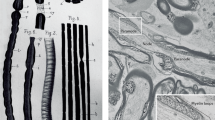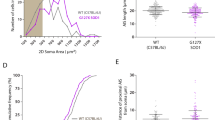Abstract
ONE of the outstanding characteristics of multiple sclerosis and other clinical and experimental diseases associated with demyelination, is the tendency to remit. Although there is good evidence that an important cause of functional loss in such conditions is conduction block produced by the selective destruction of the myelin sheath1, the mechanisms underlying remission are unknown2. It has long been recognised that in certain experimental lesions demyelinated central axons can be remyelinated by the normal myelin-forming cell, the oligodendrocyte3. The new sheaths are, however, abnormally thin and short and it is not known whether they are capable of restoring conduction. A previous investigation was inconclusive4. Because of the physiological and clinical importance of this problem, we have now examined conduction serially through the lesion induced by the direct microinjection of lysophosphatidyl choline (LPC) into the cat spinal cord5. This lesion has the advantage that the phases of active demyelination and remyelination are well separated, thus permitting a reasonable correlation of the morphological with the physiological changes. We have found that secure conduction is restored with remyelination.
This is a preview of subscription content, access via your institution
Access options
Subscribe to this journal
Receive 51 print issues and online access
$199.00 per year
only $3.90 per issue
Buy this article
- Purchase on Springer Link
- Instant access to full article PDF
Prices may be subject to local taxes which are calculated during checkout
Similar content being viewed by others
References
McDonald, W. I. Brain 97, 179 (1974).
McDonald, W. I. Br. med. Bull. 30, 186 (1974).
Bunge, M. B., Bunge, R. P. & Ris, H. J. biophys. biochem. Cytol. 10, 67 (1961).
Mayer, R. F. Int. J. Neurosci. 1, 287 (1971).
Blakemore, W. F., Eames, R. A., Smith, K. J. & McDonald, W. I. J. neurol. Sci. 33, 31 (1977).
McDonald, W. I. & Sears, T. A. Brain 93, 583 (1970).
Smith, K. J. J. Physiol., Lond. 276, 7P (1978).
Bostock, H. & Sears, T. A. J. Physiol., Lond. 280, 273 (1978).
Rasminsky, M., Kearney, R. E., Aguayo, A. J. & Bray, G. M. Brain Res. 143, 71 (1978).
McDonald, W. I. & Halliday, A. M. Br. med. Bull. 33, 4 (1977).
Prineas, J. W. & Connell, F. Annls. Neurol. 5, 22 (1979).
Gledhill, R. F. & McDonald, W. I. Annls. Neurol. 1, 552 (1977).
Harrison, B. M. & McDonald, W. I. Annls. Neurol. 1, 542 (1977).
Blakemore, W. F. Neuropath. appl. Neurobiol. 4, 47 (1978).
Blakemore, W. F. Nature 266, 68 (1977).
Author information
Authors and Affiliations
Rights and permissions
About this article
Cite this article
SMITH, K., BLAKEMORE, W. & MCDONALD, W. Central remyelination restores secure conduction. Nature 280, 395–396 (1979). https://doi.org/10.1038/280395a0
Received:
Accepted:
Published:
Issue Date:
DOI: https://doi.org/10.1038/280395a0
This article is cited by
-
FKBP5 activates mitophagy by ablating PPAR-γ to shape a benign remyelination environment
Cell Death & Disease (2023)
-
Glia Connect Inflammation and Neurodegeneration in Multiple Sclerosis
Neuroscience Bulletin (2023)
-
White matter tract conductivity is resistant to wide variations in paranodal structure and myelin thickness accompanying the loss of Tyro3: an experimental and simulated analysis
Brain Structure and Function (2022)
-
Transcriptomic analysis of loss of Gli1 in neural stem cells responding to demyelination in the mouse brain
Scientific Data (2021)
-
Neuroprotective effects of Sonic hedgehog agonist SAG in a rat model of neonatal stroke
Pediatric Research (2021)
Comments
By submitting a comment you agree to abide by our Terms and Community Guidelines. If you find something abusive or that does not comply with our terms or guidelines please flag it as inappropriate.



